You are here
New Releases

UNFPA Regional Situation Report For the Syria Crisis — February 2023
The Regional Situation Report for the Syria Crisis offers a bird’s eye view of UNFPA’s operations within the context of the Syria crisis. In addition to providing aggregated quantitative results for each country involved in UNFPA regional Syria response, this report also brings stories from the field that highlight the plight of communities inside Syria and in host countries, underscoring the positive impact of the response delivered by UNFPA in the areas of sexual and reproductive health, gender-based violence, youth engagement, and others.

State of world population report 2023 Highlights - 8 Billion Lives, INFINITE POSSIBILITIES
In November 2022, the world’s population surpassed 8 billion people. Our human family is now larger than ever before. Collectively, we live longer and enjoy healthier lives than at any other point in human history. Yet ours is also a world of anxiety and uncertainty. Challenges like climate change, economic upheaval, confl ict and COVID-19 have brought us to a crossroads, where the threat of a worse future for humanity feels just as possible as the promise of a better one.

Türkiye-Syria Earthquake Joint Situation Report #3
In the early hours of 6 February 2023, multiple earthquakes, the strongest being of 7.7 magnitude, struck southern Türkiye and northern Syria, creating a disaster of colossal proportions. Following the initial quake, around 17,000 aftershocks occurred until March 13, highlighting the vulnerability of the region to future earthquakes and the severe risks facing communities.
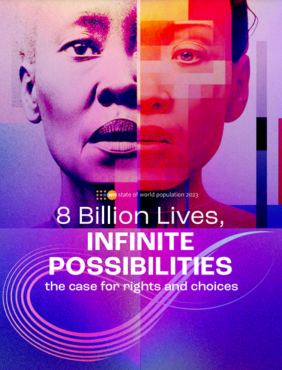
State of World Population report 2023 - “8 Billion Lives, Infinite Possibilities: the case for rights and choices”
Ours is a world of hope and possibility, a world where the human family is larger than ever before. It is a world in which we are collectively living longer and, on balance, enjoying better health, more rights and broader choices than at any other point in human history. Ours is also a world of anxieties: the tensions of everyday life are rapidly accumulating amid economic uncertainty, the existential question of climate change, the still-rising toll of the COVID-19 pandemic and the ongoing ravages of conflict. In November 2022, the United Nations announced that the human population had surpassed 8 billion people, and also that two thirds of people were living in places where fertility rates had fallen below the so-called “replacement level” of 2.1 births per woman. These trends offer a nuanced look at demographic transition — the shift from higher to lower mortality and fertility — as it unfolds in different countries and contexts. But the subtleties of this story were very often lost. “Too many” people will overwhelm the planet, many pundits proclaimed, even as others warned that “too few” people would lead to civilizational collapse. Every population trend seems to invoke its own vision of catastrophe. Too many young people? Destabilizing. Too many old people? A burden. Too many migrants? A threat

AGAINST ALL ODDS
This assessment report is the sixth regional external assessment of UNFPA humanitarian programming in the Syrian and Arab States region (incorporating responses to the Syria crisis within Türkiye and cross-border from Türkiye to Syria and UNFPA humanitarian responses in Sudan and Yemen) to report on the impact on women, girls, boys, and men that UNFPA programming has had, across sexual and reproductive health (SRH), gender-based violence (GBV) and youth programmes. This 2022 assessment builds upon the previous annual impact assessments from 2016 onwards, tracking the evolution of programming through the evolution of the Syrian crisis, the COVID-19 pandemic, and for 2022, incorporation of UNFPA humanitarian response work in the countries of Sudan and Yemen.
The findings of the assessment are intended to inform UNFPA programmes, with the overall aim of enhancing the services that UNFPA provides. These findings will also be considered when designing new programmes or amending existing programmes. This report also informs the donor community to gain a better understanding of UNFPA’s operations in both the Syria regional response and the wider Arab States region.
The 2022 Impact Assessment builds on the established methodology of the 2021 Impact Assessment which rationalised and systematised the different tools and questions previously used to conduct research among three types of service delivery points (SDPs) with three primary research tools: Client Feedback Forms (CFFs) among attendees at services, Focus Group Discussions (FGDs) among attendees at services and Key Informant Interviews (KII) with institutional stakeholders – partners, service providers, UNFPA staff. The table below summarises the number of each type of research tool applied.
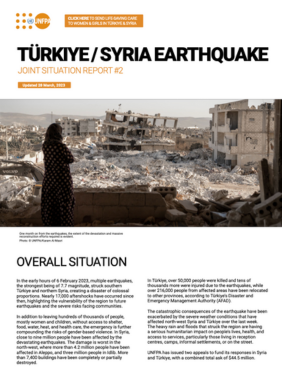
Türkiye-Syria Earthquake Joint Situation Report # 2
In the early hours of 6 February 2023, multiple earthquakes, the strongest being of 7.7 magnitude, struck southern Türkiye and northern Syria, creating a disaster of colossal proportions. Nearly 17,000 aftershocks have occurred since then, highlighting the vulnerability of the region to future earthquakes and the severe risks facing communities. In addition to leaving hundreds of thousands of people, mostly women and children, without access to shelter, food, water, heat, and health care, the emergency is further compounding the risks of gender-based violence. In Syria, close to nine million people have been affected by the devastating earthquakes. The damage is worst in the north-west, where more than 4.2 million people have been affected in Aleppo, and three million people in Idlib. More than 7,400 buildings have been completely or partially destroyed. In Türkiye, over 50,000 people were killed and tens of thousands more were injured due to the earthquakes, while over 216,000 people from affected areas have been relocated to other provinces, according to Türkiye’s Disaster and Emergency Management Authority (AFAD). The catastrophic consequences of the earthquake have been exacerbated by the severe weather conditions that have affected north-west Syria and Türkiye over the last week. The heavy rain and floods that struck the region are having a serious humanitarian impact on people’s lives, health, and access to services, particularly those living in reception centres, camps, informal settlements, or on the street. UNFPA has issued two appeals to fund its responses in Syria and Türkiye, with a combined total ask of $44.5 million.
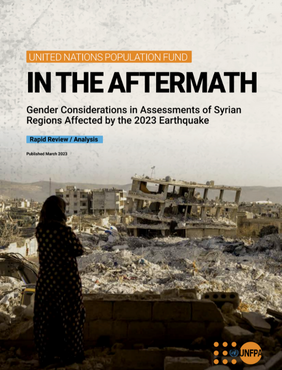
IN THE AFTERMATH - Gender Considerations in Assessments of Syrian Regions Affected by the 2023 Earthquake
On 6 February 2023, a magnitude 7.8 earthquake and multiple severe aftershocks struck Syria and Turkey, affecting multiple governorates including Idlib, Aleppo, Lattakia, and Hama. Prior to the earthquake, 15.3 million people were estimated to be in need of humanitarian assistance throughout Syria. For most Syrians, this earthquake only compounds existing suffering; 15 March marks 12 years since the start of the conflict which has caused massive displacement, economic collapse, and widespread violence. With approximately 1.9 million people living in around 1,430 camps or self-settled sites in the north-west of Syria (NWS), with 80 percent (1.5 million) being women and children. Syria remains the world's largest internal displacement crisis. The earthquakes have caused new internal displacement movements and at least 86,000 people were reportedly newly displaced since the earthquake happened.
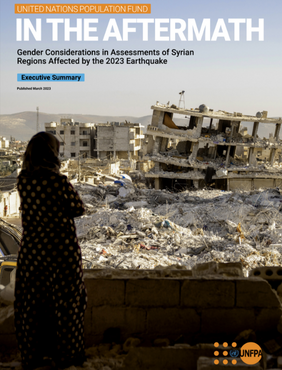
IN THE AFTERMATH - Gender Considerations in Assessments of Syrian Regions Affected by the 2023 Earthquake "Executive Summary"
On 6 February 2023, a magnitude 7.8 earthquake and multiple severe aftershocks struck Syria and Turkey, affecting multiple governorates including Idlib, Aleppo, Lattakia, and Hama. Prior to the earthquake, 15.3 million people were estimated to be in need of humanitarian assistance throughout Syria. For most Syrians, this earthquake only compounds existing suffering; 15 March marks 12 years since the start of the conflict which has caused massive displacement, economic collapse, and widespread violence. With approximately 1.9 million people living in around 1,430 camps or self-settled sites in the north-west of Syria (NWS), with 80 percent (1.5 million) being women and children. Syria remains the world's largest internal displacement crisis. The earthquakes have caused new internal displacement movements and at least 86,000 people were reportedly newly displaced since the earthquake happened.
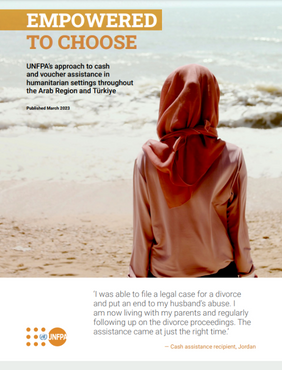
Empowered to Choose
This vital brief provides a comprehensive but succinct background on some of the commitments, considerations, and lessons learned surrounding the cash and voucher assistance (CVA) operations in the region and evidence from the field to reinforce main conclusions.
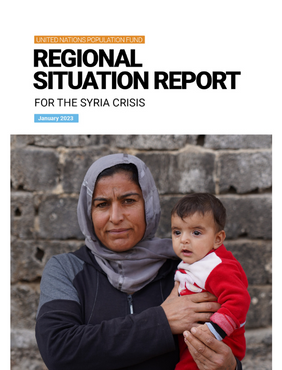
UNFPA Regional Situation Report For the Syria Crisis — January 2023
As of early 2023, Syrians and host communities throughout the region prepare for one of the worst years of the crisis. People in need continue to face the escalating impact of a protracted conflict, further complicated by a collapsing economy, climate-related challenges, and chronic and emerging health threats, including an unrelenting pandemic and a worsening cholera outbreak.